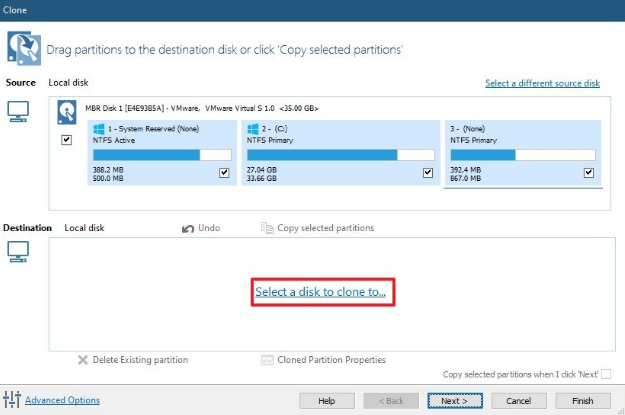

- #MACRIUM REFLECT CLONE WIN10 INSTALL#
- #MACRIUM REFLECT CLONE WIN10 UPGRADE#
- #MACRIUM REFLECT CLONE WIN10 FULL#
- #MACRIUM REFLECT CLONE WIN10 WINDOWS 10#
- #MACRIUM REFLECT CLONE WIN10 PC#
Of course, substitute the disk number for your own configuration. If it doesn’t point to the right disk immediately, you can adjust the command to mbr2gpt /validate /disk:0 to force it to run on disk 0. Exit diskpart, and run the following command: mbr2gpt /validateĬheck two things: that the command is pointing to the right drive, and that the validation completes successfully. The old SSD is not GPT partitioned, the new SSD is indeed GPT style (because I played around with it during troubleshooting). In this screenshot, you can see that Disk 0 is my old 500GB SATA SSD and Disk 1 is my new 1TB NVMe M.2 SSD. In there, run diskpart to verify the correct drive number: Once rebooted, navigate through the options until you get a command prompt.
#MACRIUM REFLECT CLONE WIN10 WINDOWS 10#
This will cause your Windows 10 system to reboot into the advanced startup mode, which (among other options) gives you a command prompt. Find Advanced startup, and restart your system. Open up the Windows Settings, go to Updates & Settings, select Recovery. Fortunately, with Windows 10 Creators Edition, that’s fairly simple. So I had to convert my existing SATA SSD that housed my Windows 10 installation from MBR to GPT. Do continue reading if your curious though… 😉 Convert from MBR to GPTĪ UEFI system will only boot from a GPT drive. If you already see GUID Partition Table (GPT), this fix might not apply to you. In the Partition style field, you should see Master Boot Record (MBR). Locate your old SATA SSD drive, right click the drive and choose properties. I created a Windows 10 Recovery Drive and (on advice of a dear friend), created a CloneZilla USB stick.Ī quick check to see if this post applies to your situation is to open disk manager (right-click the Windows “start” button, choose disk management). It also helps if you have another system/laptop and a few 4-8GB USB sticks nearby, so you can create a few tools that will help along the way.
#MACRIUM REFLECT CLONE WIN10 PC#
Leave the PC cover off, because you might be unplugging and connecting drives a few times. I have a 6TB WD Red drive in there as well, so I unplugged that to make sure I wasn’t going to accidentally format it. If there’s anything important on your drives, make a backup. Commands in this post have the potential to ruin your installation. Preparations: backup and unplug other drivesįirst of all, the mandatory disclaimer.
#MACRIUM REFLECT CLONE WIN10 UPGRADE#
So what did enable me to clone clone Windows 10 from SATA SSD to M.2 SSD? I had to upgrade to a UEFI Windows 10 installation, with a GPT partition style! Fortunately, that’s not as hard as it sounds. I kept getting Inaccessible Boot Device errors, the bootrec and bcdedit commands didn’t find my Windows installation, and changing drive letters with diskpart didn’t do anything either. There is a important distinction here.Īll this meant I could clone and play around with bootrec and bcdedit all day long, but it wasn’t going to solve my problem. It also means that my Windows 10 installation had a “system partition” instead of an “EFI system partition”. What this in effect means is that my old SATA SSD was formatted with MBR instead of GPT (it’s a partitioning scheme). This is probably because it ran Windows 7 or 8 a few years ago or just because I never changed it from the default mode. In that old BIOS, my storage devices were set to Legacy mode instead of UEFI. I was running a really old BIOS, and never properly set it up when I initially installed Windows 10 many years ago. I’m still not 100% sure why, so feel free to comment below! In the end however, my problem had more to do with the difference between BIOS and UEFI, and how storage devices are addressed. While googling for solutions, many solutions mentioned the bootrec.exe, bcdedit.exe and diskpart commands to solve the boot issues. The main recurring error was Inaccessible Boot Device, however in my troubleshooting attempts I saw many more errors.

Long story short: I cloned the old SSD to the M.2 SSD, rebooted from the M.2 SSD, and… was greeted with a variety of errors. Instead, I wanted to clone Windows 10 from SATA SSD to M.2 SSD.Īfter a little bit of research, I ended up with Macrium Reflect, which is freeware disk cloning software. There’s just too many applications, settings and licenses on that system that I didn’t want to recreate or re-enter.
#MACRIUM REFLECT CLONE WIN10 FULL#
I wasn’t really looking forward to a full reinstallation of Windows 10 though.
#MACRIUM REFLECT CLONE WIN10 INSTALL#
The physical installation is dead simple: remove graphics card, install M.2 SSD, reinstall graphics card. Nevertheless, those specs got me to pick up a screwdriver and install the new M.2 SSD. I already had a SATA SSD installed in my gaming/photo editing PC. A few weeks ago I received a 1TB Western Digital Black SN750 M.2 SSD, boasting an impressive 3470 MB/s read speed on the packaging.


 0 kommentar(er)
0 kommentar(er)
